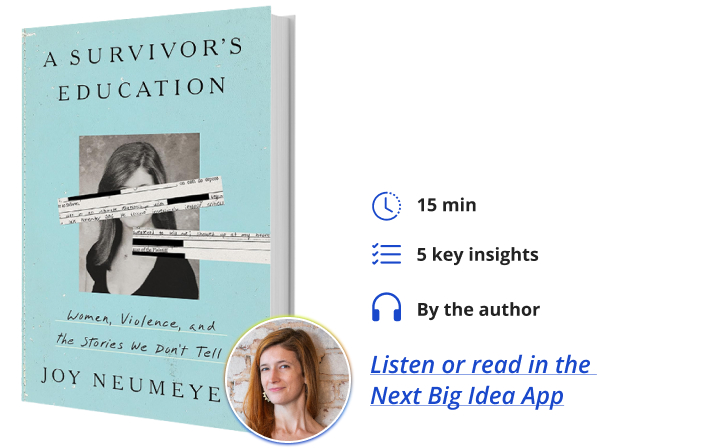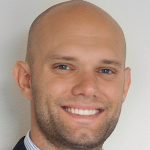Joy Neumeyer is a historian and journalist who writes about culture, power, protest, and women’s rights. She specializes in Russian and Eastern European history, and her essays have appeared in The New York Times, the Nation, the Atlantic, and New Left Review.
Below, Joy shares five key insights from her new book, A Survivor’s Education: Women, Violence, and the Stories We Don’t Tell. Listen to the audio version—read by Joy herself—in the Next Big Idea App.

1. To challenge power, change the story.
I came to the University of California, Berkeley, in 2014 to study Russian and European history. For my PhD, I spent a lot of time studying examples of how authoritarian strongmen like Joseph Stalin manipulated their citizens by controlling the national narrative. These topics started to resonate on a more personal level for me when I started dating a close friend in my graduate program—and he became violent. To my own amazement, I quickly found myself going along with things that completely went against my principles. I did it because my partner was telling a compelling story—to me, as well as to our friends and colleagues—about how he was the victim and needed support and understanding. As I started to connect what I was experiencing in my personal life to my historical research, I grew to realize how and why people in political systems such as Stalin’s Soviet Union went along with totalitarian rule: they internalized the narrative that the authorities were telling them.
What most helped me understand the relationship between power and storytelling was reading the work of Czesław Miłosz, who defected to the U.S. from Stalinist Poland in the early ‘50s. After his defection, he wrote a book called The Captive Mind, which emphasized that power comes less from physical coercion than from convincing people that they’re doing the right thing. Reading the words of historical witnesses like Miłosz helped me understand that breaking free from the spell of abusive power requires reframing the narrative. Soviet Communism finally fell in Eastern Europe when enough people were no longer willing to play along with the regime’s story. My abusive relationship ended when I stopped believing what my partner was telling me, and I created my own account of what was happening. If power is rooted in the dominance of a particular story, then resistance begins with writing a new one.
2. Seek out the invisible.
After I left my abusive boyfriend, I filed a Title IX complaint against him to try to keep myself and others safe. Title IX is a law that guarantees equal access to education for people of all genders. If you file a complaint with your university saying that you have experienced gender-based violence or harassment, the institution might launch an investigation of what happened to determine how it should respond.
And that’s exactly what happened here. Suddenly, I needed to compile text messages and other proof to back up my story to a Title IX investigator—but this was quite difficult because a lot of the evidence I possessed had been censored by, well, me. I had sent texts to friends with phrases like “Something bad happened,” but I didn’t specify what I meant. After all, since I’d sympathized with my boyfriend and felt protective of him, I had avoided telling people exactly what he had done.
“It’s not enough to take sources at face value; all the documents we have about the past and present are warped by their creators’ intentions.”
While the Title IX investigation was ongoing, I went to Russia to do research for my PhD and uncovered the same kind of silence at an archive in Moscow. I was looking through letters written by a woman named Liza, who was the wife of someone I was researching, when I came across euphemisms and vague descriptions similar to those that I had used in my own correspondence. For example, in a letter that Liza sent her mother about her marriage, she wrote, “Fear, etc.” I wondered what lay behind this phrase.
It’s not enough to take sources at face value; all the documents we have about the past and present are warped by their creators’ intentions. As a professor of mine put it, you have to “read sources against the grain”—to look for traces of what’s been left out and why. Historians regularly use these techniques while researching subjects like slavery, as most of the written sources were created by enslavers who were trying to justify their own grip on power. In Liza’s case, as I continued to gather different archival materials, I became convinced that this person had experienced domestic violence despite the fact that she never explicitly said so. This kind of cross-referencing and pattern recognition was also critical in investigating my Title IX case. To gain insight into any subject, listening to what’s not being said is vital. We must consume information critically and seek out the invisible.
3. Let the facts guide the narrative.
As I read media commentary about Title IX, I often encountered the argument that it had “gone too far.” According to this narrative, flimsy accusations were frequently ruining the lives of innocent men who had been terrorized into silence. For example, Slate reporter Emily Yoffe wrote that students accused of sexual violence at universities now encounter a “Soviet-style show trial” in which their guilt is preordained by administrators who “default to calling for the accused’s head.” To find out what was really going on, I looked for data. It turned out that lots of large educational institutions, including Berkeley, now release reports every year about the Title IX complaints they received. As I read these reports, I discovered that it’s actually very rare for a complaint to result in an investigation or any sort of punishment for the accused person.
The tendency to fall back on a prefabricated narrative at odds with the facts is near-universal. We’re often overly confident that we understand a situation or that we know a particular person well, and we selectively choose evidence that confirms our biases. This type of thinking can have harmful consequences. Under the influence of the popular narrative about Title IX’s supposed overreach, the Trump administration implemented policy changes that made it even harder for survivors of violence on campus to come forward because the bar they faced was so high. A recent study by the organization Know Your IX found that 39 percent of survey respondents who reported sexual misconduct experienced “substantial disruptions” to their education; almost 10 percent dropped out. Many of the students who experience violence on campus and bear the consequences are queer students and women of color. We need to let the facts guide the narrative and consider who might be left out or harmed by our assumptions.
4. Balance distance with intimacy.
While training to become a historian, I learned to observe from a distance. In the 19th century, a scholar named Leopold von Ranke helped create history as a modern discipline by moving it away from philosophy and closer to the natural sciences. He thought that the historian’s job was to impartially depict the past “as it actually was,” through the study of archival documents. This idea that history is objective came under serious question in the 1980s, when the philosopher of history, Hayden White, said that objectivity is an illusion. According to White, the past is chaos, a sea of disparate events on which historians impose order in the form of a literary plot. They mold raw materials into a familiar structure that reflects their moral and political impulses. According to White, it’s impossible to approach the past neutrally because historians are always projecting what they want to see.
“Acknowledging and incorporating what makes you you into your work can unlock new ideas.”
Over the course of my historical research and my recovery from abuse, I came to see how both these positions are true. Even if we can and should strive to be fair and accurate in our analysis, we can never fully overcome our personal commitments and concerns. But this can be a good thing. Acknowledging and incorporating what makes you you into your work can unlock new ideas.
After I finished my PhD, I wrote an essay for the main academic journal in my field, the American Historical Review, that interlaced my personal experience of abuse and the investigation with my historical and philosophical interests. I got so many responses from people who related to what I wrote that I broadened this essay into a book. Of course, exposing something personal carries risks; you may attract some people and alienate others. But the benefits can outweigh the drawbacks. Odds are that if you balance distance with intimacy, you’ll add new layers of meaning to what you do and connect with more people.
5. Closure is something we create.
When my Title IX case was getting started, I talked with a confidential advocate who offered psychological support and advice. She warned me that regardless of what the university concluded about my complaint or decided to do in response, the institutional process would not provide “closure.” Closure, she said, was something that I had to find for myself. I later spoke with other survivors of harassment or abuse who went through the Title IX system and had wildly different outcomes. One person dropped out of graduate school and went on to do something else. A couple of others decided to stay in academia and try to make things better there. What united all of them, and what inspired me, is that they moved forward on their own terms.
We often have little to no control over things that happen to us in life. This can feel maddeningly disempowering. Yet, we can reassert our autonomy by creating meaning out of our experiences. Rather than trying to forget about my experience of abuse, I wanted to understand how it related to a bigger history. For example, I researched the murder of a Berkeley student named Tanya Tarasoff, who was killed in 1969 by a grad student whom she briefly dated. I wanted to know why her story ended the way it did while my life continued. I concluded that some key differences that divided our fates were structural. Back in 1969, there was no law or conceptual framework (like “intimate partner violence”) that could have identified what Tanya was experiencing or helped her get away. Title IX didn’t exist; neither did restraining orders, shelters, or any of the other tools that support survivors today. Connecting my experience to a case from the past helped me appreciate how the tools we’ve recently developed, however flawed they might be, are essential to improve and protect.
By bringing my story together with those of other people, I saw that although we are constantly affected by external forces, we are not simply victims of circumstance. We can use what we’ve learned to advocate for what we believe in, thanks to the knowledge we’ve gained. We can keep rewriting, revising, and adding new layers of interpretation to our personal and collective history, which we leave for the next generation to keep refining. Since closure is something we perpetually create for ourselves, the story never really ends.
To listen to the audio version read by author Joy Neumeyer, download the Next Big Idea App today:
































